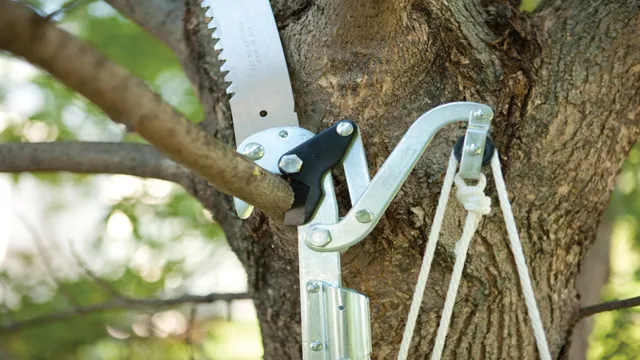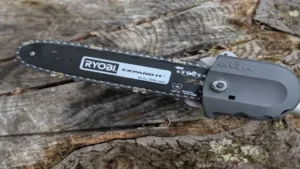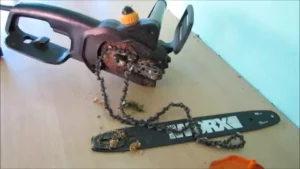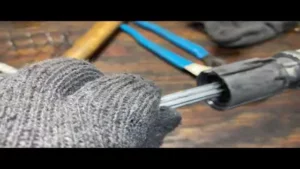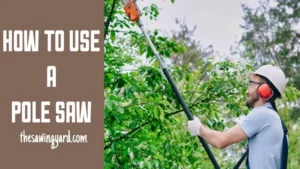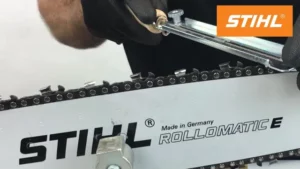If you’re a homeowner or a landscaper, you know how important pruning is to the health and aesthetics of your trees and shrubs. But reaching high branches can be a challenge, and using an ordinary saw or pruner can be dangerous without the right tools. That’s where the Fiskars Extendable Pole Saw & Pruner comes in.
This innovative tool allows you to safely and easily reach high branches, trim them, and even saw through thick branches without ever having to climb a ladder. With its lightweight design, durable construction, and extendable reach, this pole saw and pruner is an indispensable tool for anyone who cares about the appearance of their landscape and the health of their trees and shrubs. In this blog post, we’ll be taking a closer look at how to use the Fiskars Extendable Pole Saw & Pruner and how it can help you achieve the perfect landscape.
Safety First
When it comes to using a Fiskars extendable pole saw and pruner, safety should always be your top priority. Before you even start your pruning or trimming tasks, make sure you have the right gear and clothing. Wear gloves, safety glasses, and a hard hat to protect yourself from any debris that may fall from the trees.
Additionally, make sure your saw and pruner are in good working condition and properly sharpened. Always read and understand the manufacturer’s instructions and safety guidelines before use. Familiarize yourself with the safety features of the tool, such as the lock on the extendable pole, to prevent any accidents.
And remember, never use the tool above your head or in wet conditions to avoid slips and falls. With proper safety measures in place, you can efficiently and safely use your Fiskars extendable pole saw and pruner to get your pruning and trimming tasks done.
Inspect the Tool
When inspecting a tool, it’s important to prioritize safety. Before using any tool, it’s crucial to ensure that it’s in good working condition and free of any potential hazards. The first step is to check for any visible damage, such as cracks or chips.
If the tool shows any signs of damage, it should be set aside and not used until it has been properly repaired. Next, inspect the tool’s moving parts and make sure that they are properly lubricated. This will ensure that the tool operates smoothly and safely.
Additionally, inspect any blades or cutting surfaces to make sure that they are sharp and in good condition. Dull blades and surfaces can cause accidents and should be replaced or sharpened immediately. Overall, safety should always be the top priority when using any tool, and regular inspections are an important part of maintaining a safe and efficient work environment.
Remember, taking the time to inspect your tools ensures that they are operating properly and keeps you protected from potential accidents.
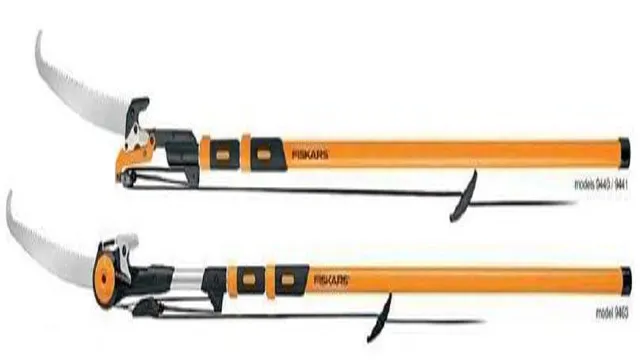
Wear Protective Gear
When it comes to any type of physical activity, safety should always be your number one priority. One of the best ways to ensure your safety is to wear protective gear. This can include helmets, knee pads, elbow pads, gloves, and more depending on the activity you are doing.
Protective gear can help reduce the risk of injuries and keep you safe during falls or collisions. For example, if you are riding a bike, wearing a helmet can significantly reduce the risk of head injuries if you fall or get into an accident. It’s important to make sure your protective gear fits properly and is in good condition before each use.
Don’t take unnecessary risks when it comes to your safety. Always wear protective gear when engaging in any physical activity.
Clear the Work Area
When it comes to working with power tools or heavy machinery, safety should always be your top priority. Before you start working, it’s essential to clear the work area of any obstacles or debris that could cause accidents. Whether you’re working in a workshop or at a construction site, taking a few moments to ensure that the area is tidy and free of clutter can make all the difference in preventing injuries or damage to equipment.
One way to approach this is by setting up designated areas for specific tasks and ensuring that tools and materials are organized. This will not only help you work more efficiently, but it will also reduce the chance of tripping hazards or equipment getting damaged. If you’re working with a team, make sure everyone is aware of the designated work areas and the importance of keeping them clutter-free.
In addition to clearing the work area, it’s important to wear appropriate safety gear, such as gloves, safety glasses, and ear protection. Always read and follow the manufacturer’s instructions for the equipment you’re using to avoid accidents, and make sure that all tools and machinery are in good working condition before use. By taking the time to clear the work area and follow safety procedures, you can reduce the risk of accidents and create a safer and more productive work environment.
Remember to prioritize safety above all else, and make sure everyone on the team is on the same page.
Using the Pruner
If you’re looking to tackle some pruning or tree-trimming tasks, the Fiskars Extendable Pole Saw & Pruner is a great tool to have on hand. Here’s how to use it: first, make sure the tool is set up to the correct length for your needs. The pole can be extended up to 16 feet, so you can reach high branches without a ladder.
Once you’ve got the correct length, use the pruner to clip the smaller branches first. You can use the saw blade to take care of thicker branches, following the same procedure. Always be cautious when using any type of saw or cutting tool, especially when working at heights.
Make sure to clear the area of any obstacles, and never extend the pole above your head or beyond your reach. With proper use and care, the Fiskars Extendable Pole Saw & Pruner can help you get your pruning tasks done with ease.
Attach the Pruner
When it comes to using a pruner, attaching it properly is a crucial first step. Make sure the pruner is securely fastened to the extension pole or handle before starting to use it. This will ensure that the blade is stable and doesn’t wobble while you’re pruning.
When attaching the pruner, make sure to tighten any screws or bolts that hold it in place. It’s also a good idea to inspect the blade of the pruner before starting to use it. Check for any signs of damage or wear, and make sure the blade is sharp.
A dull blade can make it more difficult to cut through branches, and can also be dangerous. By properly attaching the pruner and inspecting the blade, you can ensure a smooth and safe pruning experience.
Adjust the Length
Adjust the Length of your trees or shrubs can be done using a pruner. It’s essential to keep your plants neat and tidy, encouraging new growth and keeping their shape. A pruner makes the job easy, but it’s important to use it correctly.
Begin by identifying the branches that need pruning, and check the thickness of each branch, ensuring the pruner is suitable for the job. Hold the pruner with both hands and place it at the base of the branch you wish to remove. Cut in one swift movement, ensuring the blade is sharp to prevent any damage to the branch and stop bacteria from entering the wound.
By regularly pruning your trees or shrubs, you can control their height, ensure their health and longevity, and keep them looking their best.
Identify the Branch
When it comes to pruning your trees, it’s essential to know how to identify the branch that needs to go. One of the best tools for this job is the pruner. This handy little tool is designed to help you cut away unwanted branches easily and efficiently.
But before you start using it, you need to know what to look for. Start by identifying any branches that are crossing over each other, or that are rubbing against other branches. These limbs can eventually damage the tree or cause it to become diseased, so it’s important to remove them.
You should also prune away any branches that are growing too close together, or that are growing at odd angles. This will help the tree maintain a healthy balance of foliage and growth. By using the pruner to selectively remove unwanted branches, you can help your tree thrive for years to come.
Position the Cutting Blade
When using a pruner, it is important to position the cutting blade correctly to ensure a smooth and accurate cut. Start by holding the pruner in your dominant hand and opening the blades by squeezing the handle. Then, locate the branch or stem that you wish to prune and position it between the jaws of the pruner.
Make sure that the blade is angled towards the section of the stem or branch that you want to remove. Close the blades by releasing the handle and allow the sharp blade to cut through the wood. It’s essential to repeat the process on the other side of the stem to avoid damaging the bark.
By positioning the cutting blade of the pruner correctly, you can achieve neat and precise cuts that will promote healthy growth of your plants.
Make the Cut
When it comes to pruning, using the right tool is crucial. The pruner is the perfect tool for precision cutting. Its sharp blades make clean cuts, ensuring that the plant heals quickly and doesn’t suffer from disease or insect infestation.
To use a pruner, first, identify the stem, branch, or leaf that needs to be cut. Position the pruner blades around the stem or branch, making sure that the blades are sharp and aligned. Then, make a quick, clean cut, positioning the blades at a 45-degree angle to the stem.
This angle ensures that water droplets will slide off the cut, preventing moisture from sitting on the plant. Using a pruner will not only keep your plants healthy but also help them grow. So, give your plants the perfect trim with a pruner and enjoy a thriving garden.
Using the Pole Saw
Are you wondering how to use the Fiskars extendable pole saw and pruner? Well, it’s actually quite simple once you get the hang of it. First, make sure the tool is fully extended and secure. Then, find the branch you want to prune or cut and place it inside the pruner.
Make sure the blade is lined up correctly with the branch before squeezing the trigger. Once the branch is cut, pull it away and discard it properly. It’s important to remember to wear protective gear, such as gloves and eye protection, and to always stay aware of your surroundings while using the pole saw.
With practice, you’ll be able to make smooth cuts and maintain your trees and bushes with ease.
Attach the Saw
When it comes to using a pole saw, one of the key steps is attaching the saw to the pole. This may sound simple, but there are a few things to keep in mind to ensure that you do it safely and effectively. First and foremost, you need to make sure that the pole and saw are compatible, as not all products work together.
Once you’ve confirmed this, you can begin the process of attaching the saw. Typically, this involves sliding the saw blade onto the end of the pole and securing it in place with screws or clamps. It’s important to follow the manufacturer’s instructions carefully, as the process may differ depending on the specific product.
Above all, take your time and make sure that everything is securely fastened before you start cutting. By doing this, you can ensure that your pole saw is working at its best and help prevent any accidents or mishaps.
Adjust the Length
Adjusting the length using a pole saw is an essential part of pruning trees or trimming bushes. This tool comes with an adjustable telescopic pole that can be extended or reduced depending on the height of the branch. To accomplish this, loosen the locking mechanism that holds the pole in place, extend or shorten the pole to the desired length, and then re-tighten the locking mechanism so that the pole remains secure.
It’s essential to ensure that the pole is securely in place, as it can be hazardous if it suddenly shifts or collapses during use. Using a pole saw is an efficient and effective way to maintain trees and shrubs, but it’s critical to follow proper safety precautions and adjust the length of the saw before use. With a few simple steps and a little practice, anyone can use a pole saw to keep their yard looking its best.
Position the Saw Blade
When it comes to using a pole saw, one of the most important things to consider is the positioning of the saw blade. For optimal cutting performance, it’s important to ensure that the blade is positioned at the correct angle and height. Generally, you want to aim for a cutting angle of around 60 degrees, as this will allow the saw to slice through branches cleanly and easily.
In addition, you’ll want to make sure that the saw blade is at the right height for the branch you’re cutting. Ideally, you want to position the blade at the point where the branch meets the trunk or main stem of the tree. This will ensure that you’re able to make a clean cut without damaging the surrounding bark or wood.
By taking a little time to properly position the saw blade, you can make quick work of even the thickest branches and keep your trees healthy and well-maintained all season long.
Start the Cut
When it comes to using a pole saw to prune trees, starting the cut is essential to prevent damaging the branches and the tool. Make sure you are standing on stable ground and have a good grip on the pole saw before proceeding. Identify the branch you want to remove and position the saw at a 45-degree angle.
Gently rest the blade on the wood and apply slight pressure to make an initial notch. This will provide a guide for the saw to follow. Once you have your starting point, increase the pressure and begin sawing back and forth in a smooth motion.
Keep the blade parallel to the bark and make sure to maintain the angle of the initial cut. With practice, you’ll be able to make clean cuts without any tearing or splintering of the branches. Remember to take breaks and step back to evaluate your work as you go to avoid overcutting or making uneven cuts.
By following these steps, you’ll have the confidence to start cutting like a pro with your pole saw.
Finish the Cut
Using a pole saw to finish the cut can be a game-changer for those in the forestry and landscaping business. The process is quite simple, but it requires patience and precision. Once you have your desired branch in sight, make sure your ladder is secure and extend the pole saw to reach it.
Once you have positioned yourself accordingly, start the saw and make the initial cut at the bottom of the branch. Afterward, move up to the top of the branch and make the final cut just a few inches away from the initial cut. This two-cut process prevents the bark from splitting and tearing, ensuring a clean and smooth cut.
It’s important to note that safety should always come first when using any type of cutting equipment, so it’s crucial to wear protective gear and follow all safety precautions. With practice and proper technique, using a pole saw to finish the cut can be both efficient and effective.
Maintenance and Storage
If you’re looking for a reliable pole saw and pruner, the Fiskars Extendable Pole Saw & Pruner is an excellent choice. But like any tool, it requires proper maintenance and storage to ensure it lasts for a long time. After using the saw, make sure to wipe it down with a clean cloth to remove any dirt or debris.
You should also inspect the saw and its blade, ensuring there’re no chips, nicks, or other damage. If you find any damage, it’s essential to repair or replace the blade before using it again. For storage, it’s best to keep the saw and its blade in a dry, cool place where it won’t be exposed to moisture or sunlight.
It also might be worth investing in a sheath or cover for the saw blade to keep it protected while in storage. By taking care of your Fiskars Extendable Pole Saw & Pruner, you can ensure it will work efficiently and safely whenever you need it.
Clean the Tool
Maintaining and storing your tools properly is key to ensuring their longevity and optimal performance. When you’re finished using a tool, one of the first steps you should take is cleaning it. This can be as simple as wiping it down with a clean rag or using a specialized cleaning solution.
The goal is to remove any debris or residue that may have accumulated while using the tool. Not only does a clean tool function better, but it also prevents any harmful buildup from affecting its performance. By taking good care of your tools, you’ll be able to use them for years to come.
Store the Tool Safely
When it comes to maintaining your tools, it’s not just about keeping them clean and sharp. Proper storage is also important to ensure that they last for as long as possible and remain safe to use. When storing your tools, it’s best to keep them in a dry, cool place that is free from moisture and direct sunlight.
This will prevent rust from forming on metal parts and ensure that wooden handles stay free from rot. Additionally, keeping your tools organized can make it easier to find what you need and prevent accidents from happening. Consider using a labeled tool chest or hanging your tools on a pegboard to keep everything in its place.
By taking the time to store your tools properly, you can ensure that they stay in good condition and are safe to use whenever you need them.
Conclusion
With the Fiskars Extendable Pole Saw & Pruner, you’ll feel like a gardening superhero. Whether you need to tackle pesky branches or snip away dead foliage, this tool will make quick work of any job. The extendable pole allows you to reach even the tallest trees with ease, while the pruner takes care of smaller cuts with precision.
So go ahead and channel your inner Tarzan (or Jane) and make your garden the envy of the neighborhood. Just don’t forget to yell “Timber!” before you start sawing.”
FAQs
What is a Fiskars extendable pole saw and pruner used for?
The Fiskars extendable pole saw and pruner is a versatile gardening tool used to trim and prune trees and hard-to-reach bushes.
How do you assemble a Fiskars extendable pole saw and pruner?
To assemble the Fiskars extendable pole saw and pruner, attach the saw blade or pruner head onto the end of the pole using the locking mechanism provided.
How do you properly use the saw blade on the Fiskars extendable pole saw and pruner?
When using the saw blade attachment, make sure that the blade is fully extended before use and use the saw in a back and forth motion to make clean cuts.
How do you properly use the pruner head on the Fiskars extendable pole saw and pruner?
To use the pruner head attachment, position the blades around the branch you want to prune and squeeze the handle to make a clean cut.
Can the length of the Fiskars extendable pole saw and pruner be adjusted?
Yes, the length of the pole can be adjusted by twisting the black locking collar near the base of the pole and sliding the pole to the desired length.
How do you maintain the Fiskars extendable pole saw and pruner?
To maintain the Fiskars extendable pole saw and pruner, clean the blades after each use, lubricate them periodically, and store the tool in a dry place away from direct sunlight.
What safety precautions should be taken when using the Fiskars extendable pole saw and pruner?
Always wear protective gear such as gloves, eye protection, and closed-toed shoes when using the Fiskars extendable pole saw and pruner. Also, make sure to use the tool away from electrical wires and keep both hands on the tool at all times.
